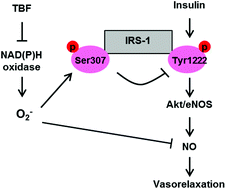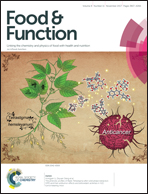Antihypertensive effects of Tartary buckwheat flavonoids by improvement of vascular insulin sensitivity in spontaneously hypertensive rats
Abstract
Vascular insulin resistance and oxidative stress contribute to endothelial dysfunction and hypertension. The present study investigated whether chronic treatment with purified Tartary buckwheat flavonoids fraction (TBF) prevents the development of hypertension via improving vascular insulin sensitivity and reducing oxidative stress. Six-week-old male spontaneously hypertensive rats (SHRs) and their normotensive Wistar-Kyoto (WKY) control rats were subjected to different dosages of TBF for 8 weeks. Blood pressure, mesenteric arteriolar vasorelaxation, superoxide anion (O2−) generation, NAD(P)H oxidase activity, and insulin-stimulated Akt/endothelial nitric oxide synthase (eNOS) activation and nitric oxide (NO) production were determined. The SHRs had higher systolic blood pressure, systemic insulin resistance, and impaired vasodilator actions of insulin and the insulin signaling pathway in mesenteric arterioles when compared with the WKY rats. TBF treatment at a dosage of 100 mg kg−1 day−1 significantly reduced systolic blood pressure and increased vasodilator response to insulin in the SHRs. Additionally, TBF treatment significantly reduced phosphorylation of insulin receptor substrate 1 (IRS-1) at serine 307 and increased insulin-stimulated Akt/eNOS activation in the SHRs. Furthermore, TBF treatment reduced the overproduction of basal O2− in association with a reduction of NAD(P)H oxidase activity in mesenteric arterioles of the SHRs. Finally, quercetin was identified as the predominant active component of TBF in attenuating the development of hypertension with regard to reducing vascular oxidative stress, regulating the vascular insulin signaling pathway and restoring vasodilator response to insulin in the SHRs. In conclusion, TBF possesses protective effects against hypertension through attenuating vascular insulin resistance and oxidative stress.



 Please wait while we load your content...
Please wait while we load your content...